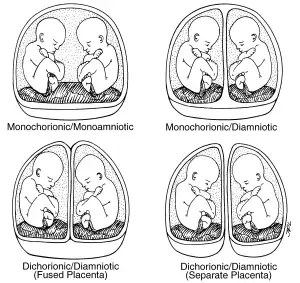Discuss the difference between amnionicity vs chorionicity and how you remember the difference. Additionally, discuss the different sonographic appearances that help you determine what kind of twins you’re dealing with, and why this might be important.
Week 10 Forum/Discussion Board: Multiple Gestations Twinning!!
Hi Everyone!
I'll be the mod for this DB and I'm excited to see all your responses!
Keep in mind that amnionicity and chorionocity are two separate things, and think about how they may relate to zygosity. I look forward to seeing all the great pictures and diagrams to help fully visualize what we would be seeing during OB scans.
-Karen
Hi everyone,
As we know by now, the chorion and amnion are two completely separate things. When it comes to twinning, some people may get the both confused when referring to them as di-di, mono-di, mono-mono, etc.
When you have 2 fetuses within one amnion, they will share the amniotic sac, placenta, and will be identical. This happens when the zygote (mono in this case) splits after 8 days... if it doesn't split until after 13 days then it can cause conjoined twinning. You could also have diamniotic within one chorion (mono-di), where twins would have separate amniotic sac but share a placenta.
When it comes to monozygosity, you could have a dichorionic pregnancy, in which case the amniotic sacs would be separated. This would happen if the zygote had split early, before the 8th day. On the other hand, dichorionic twins could be fraternal (dizygosity), when two ovums were fertilized and implanted separately. Dichorionics have separate chorion, amnion, and placenta.
One of the most telling sonographic differences would be the Lambda or Twin Peak sign and the T sign. The Lambda sign would suggest a di-di pregnancy, whereas the T sign that is much thinner, because it contains only the amniotic membrane would suggest a mono-di. These are important because more complications arise from twinning, especially when they share the same little space and "utilities," as Dr Wilson said in today's lecture.
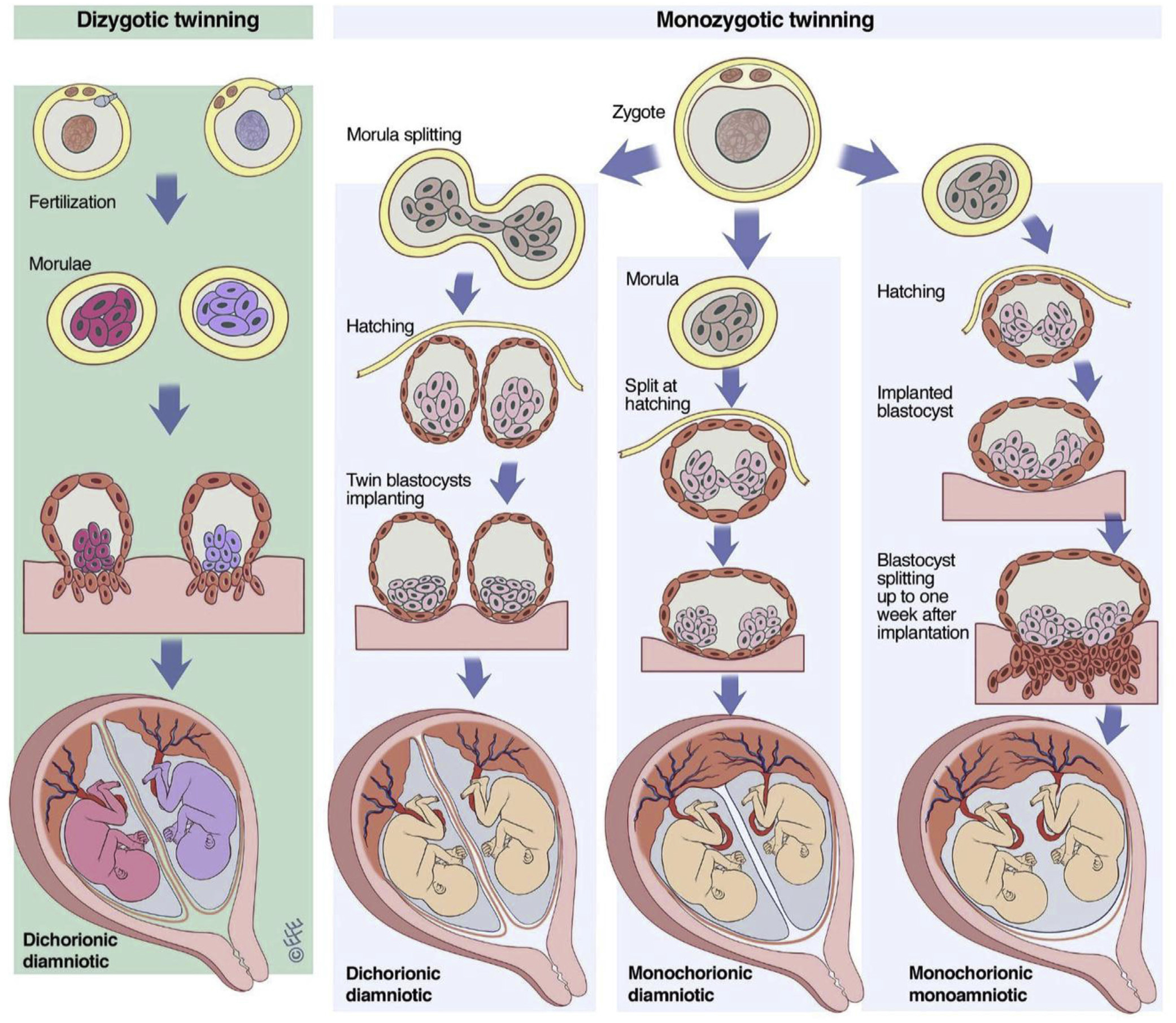
Sorry this image is so huge but it really illustrates everything well!
The differences between amnionicity and chorionicity begin at the cellular level. We know the chorion will develop from the trophoblast, also called the outer cell mass, and the amnion is formed from the embryoblast which is our inner cell mass! The chorion is the outermost layer and contains the chorion frondosum which will become the fetal side of the placenta, while the amnion lives within the confines of the chorion and is the cavity where our embryo will grow.
To remember the difference between these two you must remember where they originate. Since the chorion is from the outer cell mass it is always the exterior portion, and the same is true of the amnion which comes from the inner cell mass and will be the most interior.
There are several different sonographic appearances we can rely on to help determine what type of twinning has occurred. While it might not always be possible to tell the zygosity we should be able to make the distinction between DC/DA, MC/DA, & MC/MA especially when scanning in the first trimester.
DC/DA twins should display the twin peaks or lambda sign in early pregnancy as a result of the 4 layers (2 chorion and 2 amnion) and the thick membrane between each embryo. MC/DA will have a much thinner membrane forming the t-sign from the single chorion and two amnion. MC/MA twins will not display a membrane between twin A & B. This is because they are enclosed in the same chorion and amnion which we should be able to see with sonography.
Its important to know which type of twinning as each one presents with risks, some greater than others. If we see something that resembles a membrane in a pregnancy thought to be MC/MA we should worry for amniotic band syndrome, whereas if the pregnancy were MC/DA and we saw this it would be normal.

Hi Chrishawna,
Great job on this post! I liked how you brought it back to the cellular level, as that is where it all starts! Do you think the timing of the splitting has much to do with how twins end up in the womb?
Have you seen many multiple gestations at your site?
Hi Karen,
Yes, I definitely believe timing is important when it comes to twins :) We know that in the case of monozygotic twinning, timing is everything! Depending on when the division occurs can dictate whether we will have a DC/DA, MC/DA, or MC/MA set of twins. Also, if the division occurs to many days post conception (I believe it's around 13) then we run the risk of having MC/MA twins that are conjoined! It also seems the longer it takes for the split to occur, the higher risk the pregnancy becomes.

Amnionicity is the number of amniotic membranes that surrounds the fetuses in multiple gestations. Chorionicity is the same concept but with the chorion instead of amnion, so how many chorions are there surrounding the fetuses. I remember this because it has the different sacs right in the names! So it's really easy to remember which is which.
This can get confusing because we have Dizygotic where the fetuses are from 2 separate ova and Monozygotic where the fetuses are from one ova that split into 2.
With dizygotic twins, they will always be dichorionic/diamniotic twins with their own amnion, chorion, and yolk sacs. They'll also have their own placentas, but they can sometimes be fused.
Monozygotic twins are more tricky because theres 3 different outcomes.
- Dichorionic/diamniotic twins with 2 chorions and 2 amnions
- This will have a thick intertwining membrane and a twin peak sign
- We can also use gender as a determining factor because a male and female have to be fraternal twins
- They live in totally separate houses- separate everything
- Monochorionic/diamniotic twins with 1 chorion and 2 amnions
- This will have a thin intertwining membrane and a T sign
- They live in the same apartment building but in different apartments
- Sharing a placenta but they have their own yolk sacs and amnions
- Monochorionic/monoamniotic with 1 chorion and 1 amnions
- These fetuses live in the same apartment building and in the same apartment.
- Shared placenta
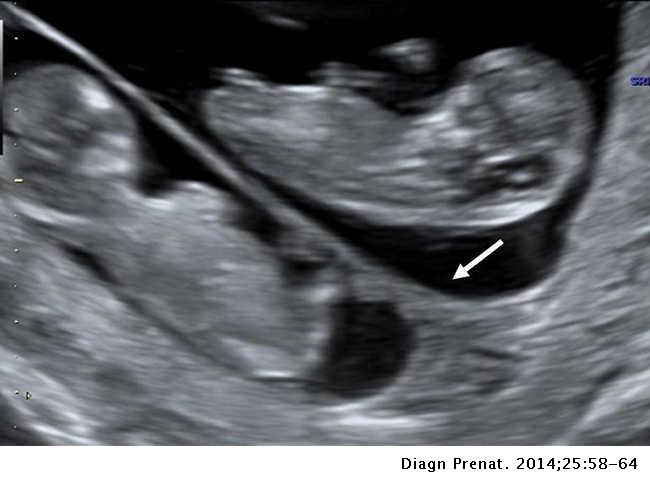
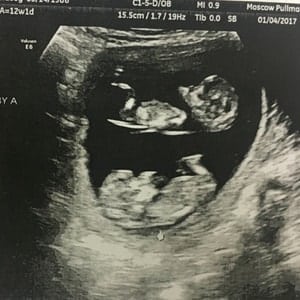 Mono/DI
Mono/DI
Di/Di
 Mono/Mono
Mono/Mono
Hi Hailey,
Excellent job on explaining the confusing parts of twinning! I feel zygosity, chorionicity, and amnionicity is complicated, yet simple if we remember fetal anatomy!
What would you do if you couldn't defferentiate between a Twin Peak sign and a T sign? How would you document this? Have you seen this at clinics yet?
Hey Karen!
well like Dr. Wilson said, later on in the pregnancy those membranes tend to thin So we can’t always count on then to give accurate information. If I couldn’t tell the difference I would try and look at earlier studies to see if it was visible in the past. If the patient doesn’t have priors, i would look for gender as well.
No I haven't seen any twins yet, sadly!!
Amnionicity refers to the number of amnions and chorionicity refers to the number of chorions. The amnion is the membrane that surrounds the amniotic cavity where the fetus lives. The chorion is the outer membrane surrounding the gestational sac which will help with developing the placenta. It helps me to remember that the chorion is the outer membrane because the chorionic frondosum and the decidua basalis are what connect and form the placenta.
The amnion appears as a thin membrane surrounding the fetus and amniotic cavity. The chorion is thicker and surrounds the chorionic cavity which contains the yolk sac. Sonographically we can see these different membranes and this helps with determining if the twins are monozygotic or dizygotic.
The lambda sign, or twin peak sign, is a sonographic finding that is seen with dichorionic diamniotic twin pregnancies. There is a thick dividing membrane between the gestational sacs made up of the two chorions and two amnions. A triangular projection of placental tissue between the sacs can also be seen. This can be seen with dizygotic and monozygotic pregnancies.
The T sign is a sonographic finding that is seen with monochorionic diamniotic twin pregnancies. The two amniotic membranes appear as a thin line that reaches up to the one placenta. This is seen with monozygotic pregnancies and raises the concern of TTTS because there is only one placenta.
If a dividing amniotic membrane is not seen between the fetuses then they are likely monochorionic monoamniotic. This is also seen with monozygotic pregnancies and there is still the concern of TTTS with this type as there is only one placenta. These types of twins are also at risk of being conjoined because there is no dividing amnion.
I've attached an image that shows the amnion and chorion for a bit of a refresher.
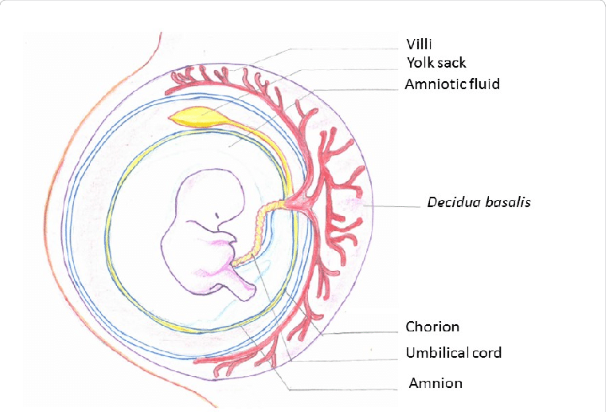
Hi Brittany!
You did a great job of bringing back what we learned and combining it with this week's topic-- it really helps connect everything to make it all make sense.
What do you think could be done if the T sign was indistinguishable? At what point in the pregnancy should you be able to visualize the T sign and Lambda sign?
Hi!
I believe the T sign and Lambda sign are best seen around 10-14 weeks gestation.
If the T sign was indistinguishable I would try to come at it from a different angle to see if the membrane would be better visualized this way. Also, noticing two yolk sacs and one placenta may be helpful for determining that there are two amnions and one chorion, even if the T sign is hard to notice. If none of these signs signaling two amnions are able to be seen then it's likely that the pregnancy is monochorionic monoamniotic.
Love this image Brittany! Here is a little tester for you!
What would you classify this pregnancy?
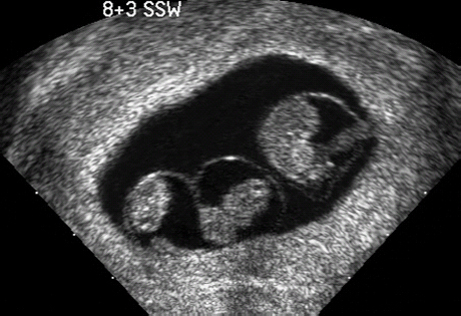
Wow... looking at the image I'm curious what the 8 represents and the SSW...
Super interesting! Thanks for sharing
Monica,
I am super curious about the captions on this too! Based on how the one of the fetuses is presenting I think its 8 gestational weeks + 3 fetuses. The reason I'm guessing 8 weeks is because the fetus on the right looks like it has midgut herniation, which is normally seen around this time. Not sure what SSW is though?
With multiple gestations, we are concerned with the relationship between two sacs: the amnion and the chorion. The chorion is part of the gestational sac and is therefore related to the placenta. The amnion is a cavity within the chorion and is where the embryo will develop. The chorion is established prior to the amnion.
Chorionicity is evaluated to determine if the twins share the same placenta (monochorionic) or have their own separate placentas (dichorionic). Dichorionic twinning is possible when there are two fertilized ova (dizygotic) or when one fertilized ovum (monozygotic) splits before day 4 post-fertilization. Dichorionic twinning can be identified by looking for the twin peak or lambda sign, ideally between weeks 10-14 of gestation. It looks like a thickened, triangular area of the placenta at the base between two chorions. The thickness of the separating membrane should be > 1.5 mm.
Amionicity is evaluated to determine if the twins share an amnion (monoamniotic) or have their own amnion (diamniotic). Diamniotic twinning occurs when there are two fertilized ova (dizygotic) or when one fertilized ovum (monozygotic) splits between days 4-8 of gestation. Diamniotic twinning can be identified by looking for the T-sign. This is a thin membrane that separates the embyros/fetuses. The thickness of the separating membrane should be < 1 mm. Monoamniotic twinning will lack the T-sign.
Twin gestations are higher risk pregnancies than singletons. The risk increases as chronicity and amnionicity decreases, with monochorionic/monoamniotic being the most risky.
The chorionicity and amnionicity combinations are as follows:
Dizygotic: dichorionic/diamniotic
Monozygotic: dichorionic/diamniotic, monochorionic/diamniotic, monochorionic/monoamniotic
Here is an illustration of the chorionic/amniotic combinations.
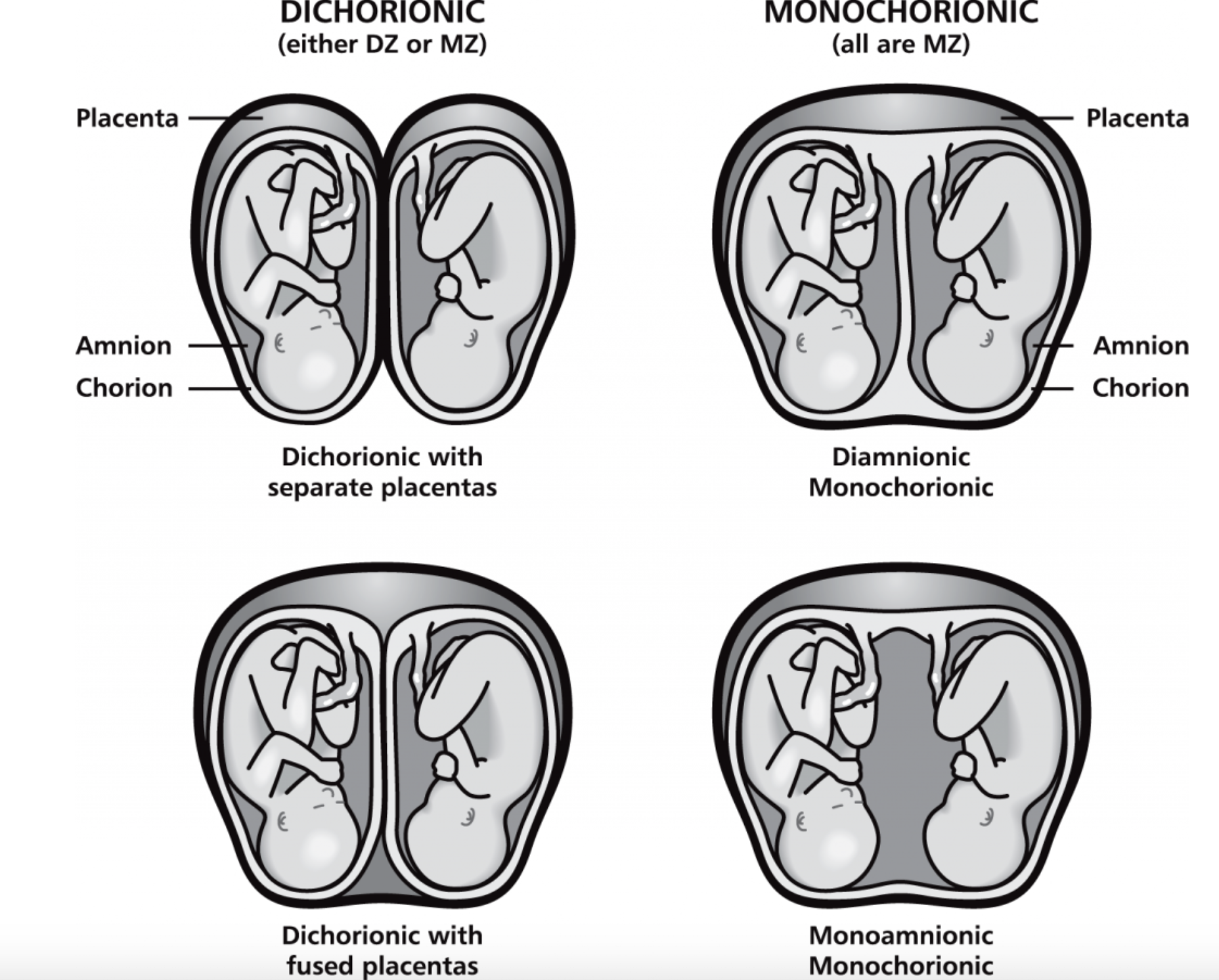
Below is a video that helped me in the few first weeks of this course. It talks about the gastrulation process, which involves the establishment of the chorion and the amnion.
Hi Alexis,
Great job in laying everything out on an easily digestible way! I liked that you included day ranges for different types of twinning to occur, and you listed all the possibilities!
What are some anomalies off the top of your head that could occur with sharing rooms as Dr Wilson put it, or amniotic sacs?
TY! As we know, having roommates can be a messy situation sometimes. *Cue the "and they were roommates" vine.* Lines can get blurred as to what is shared and what is not. For mono/mono twins, sharing the same quarters can lead to vascular anastomoses and unequal distribution of oxygenated blood between the twins. Such anomalies include TTS and TRAP. Additionally, the umbilical cords can get tangled or knotted with one another, leading to compromised blood supply for one or both fetuses. Those are the few I can think of off the top of my head!
Hi Alexis,
Absolutely lovely response. I really appreciated how included time lines, that's was a really nice refresher for me. There has been some debate in terms of whether or not the number of yolk sacs in early pregnancy can determine amnionicity. According to our book yolk sacs can determine amnionicity (pg. 677). This article: https://obgyn.onlinelibrary.wiley.com/doi/full/10.1002/uog.11160 describes this sonographic finding is not completely reliable. I think it is safe to say as sonographers we should always be prepared for things to change.
Although they may seem similar, the chorion and the amnion are distinct membranes, and they can be distinguished from one another sonographically. The amnion is the inner membrane that surrounds the embryo, and contains amniotic fluid within the amniotic cavity. The chorion is the outer layer that contains the amnion within it.
Since we can have a DC/DA placentation with either a dizygotic twin or monozygotic twin, we cannot rely strictly on the number of chorions and amnions to determine the zygosity. We can look at the genders to help us determine zygosity in this case, because monozygotic twins will always be the same gender, in contrast to dizygotic twins, which can be the opposite gender, or the same. So if we determine the twins are opposite genders, we know they are dizygotic (fraternal) twins.
With that being said, although we can’t always determine the zygosity, we are able to distinguish between DC/DA, MC/DA, and MC/MA twins. We can do this by identifying the number chorions, the number of amnions within the chorions, and the number of embryos within the amnions, along with some key sonographic signs.
-
DC/DA twins will have the “twin peak sign” aka “lambda sign”, which will appear as a thick septating membrane, thickest at the placental surface, and tapers. It’s a result of the 2 chorions and 2 amnions.
-
MC/DA twins will display the T-sign, which will appear as a thin membrane, which is formed by the 2 amnions.
-
MC/MA twins will lack an obvious intertwin membrane since they share 1 chorion and 1 amnion.
It’s important to identify which type of twinning we are dealing with, because it will predict the adverse outcomes in the perinatal period. We know monozygotic twins are at a higher risk for abnormalities and adverse outcomes. We also know MZ twins have different levels of perinatal mortality risk depending on their placentation. MZ DC/DA have a 10% risk and are associated with IUGR, MC/DA have a 25% risk and are associated with TTTS, and MC/MA have a 50% risk. The many complications associated with twins makes it crucial that we as sonographers know how to determine the type of twin, because it will greatly affect the type of care they will need.
I found this video lecture nice just to reinforce what we’ve already gone over and touch on some additional things like "twin mimics" to watch out for when scanning!
Hi Zuly,
Your post is so well organized! It's great that you added zygosity in there as well, and excellent recap on chorions and amnions for people who may confuse the two.
Have you been able to scan any twins yet? What would you see if there was a MCDA and you suspect TTTS? Is there anything you would do to confirm this?
Hey Karen!
Thank you so much, and great question. I haven't seen twins at clinic, but it would be so exciting! If suspected TTTS, I would probably look for signs such as: a marked difference between the 2 fetuses sizes, bladder fillings, and one possibly suffering from oligohydramnios, and the other from polyhydramnios. I really loved how well Allison summarized these findings in her post. In the images that pop up online of TTTS I keep noticing they depict one twin reddish color, but I haven't been able to wrap my head around what aspect of TTTS causes it, one source mentioned differences in hemodynamics, does someone else understand it?
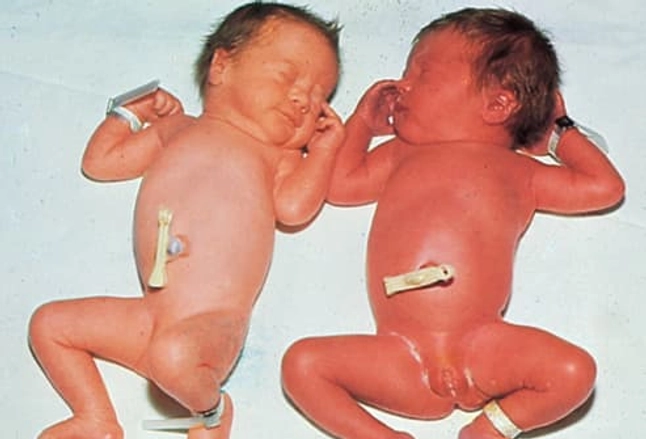

Hey Zuly,
That's an excellent question! Does anyone have answers?
Your mention of the reddish color of skin reminded me of this person I cam across while researching this week's topic
https://www.livescience.com/61890-what-is-chimerism-fused-twin.html#:~:text=The%20woman%2C%20singer%20Taylor%20Muhl,womb%2C%20she%20told%20People%20magazine.
Apparently she has "chimerism" where she has 2 sets of DNA.. from absorbing her twin! But she says fraternal twin? I would think identical would be more likely...
What do you guys think?
Hey Zuly, Great post.
I found the video interesting. The woman speaking at about (6:20) said we know that the twins are MC but she also said even though we don't see the amnion's yet we know these are DA because we see 2 yolk sacs. I thought that was interesting and honestly am not 100 percent sure that is a definitive way to tell they are DA. I found another article that concluded 2 yolk sacs are present in up to 1/3 of all MCMA twins. Very interesting!
Hey Allison!
I'm glad you brought this up. On Nailah's post below I posted an article talking about the amnionicity, and if it's reliable or not. Thus far I feel like it's not 100% reliable, and the photos I posted show a great example of how further along in a pregnancy, a MC (2 yolk sac) pregnancy can then show it's true colors to be MC/MA!
Hi Zuly,
I really enjoyed your presentation this week, you did a wonderful job hitting all of the highlights for this topic and included great images to match!! I love the flow of your post and how you mentioned the importance of understanding which type of twinning has occurred. In the case of monozygotic twins the later the split happens the higher the risk of the pregnancy. Although it is more difficult in early pregnancy, I definitely see the importance of identifying gender!
As we know the amnion is the innermost part of the placenta. It lines the amniotic cavity and holds the amniotic fluid and the developing embryo. The chorion, on the other hand, is the outer membrane that surrounds the amnion, the embryo, and other membranes and entities in the womb.
It helps me to remember that the amniotic fluid is surging the baby, therefore the amnion would be the innermost portion and the chorion is the outermost portion.
When differentiating what kind of twins I'm dealing with sonographically, I can look for the T sign or lambda sign which helps differentiate which I'm dealing with. T sign typically indicates monochorionic, diamniotic and the lambda sign typically indicates dichorionic, diamniotic.

Hi Lania!
I really like the way you remember the amnion vs the chorion, its really nice that those terms are right in the name for amnionicity and chorionicity. also don’t forget that we can also use gender as a differentiator! if we have a boy and a girl it was always be di/di- fraternal twins.
Hi Lania,
Great images! And excellent way to remember what is what when it comes to amnions and chorions.
I'm excited to hear about if you've gotten to scan a lot of multiple pregnancies?
I remember Dr Wilson saying that the Lambda Sign could sometimes almost be mistaken for the T Sign if it's too compressed... do you remember what are the measurements for both?
Hi Lania so today while I was observing a multiple gestation pregnancy I observed a T sign and a Lambda sign together separating the two fetuses. I might be stupid for not knowing this before or not connecting the dots but I learned that you should look at the fetus' placental sides to determine what kind of membrane the fetuses have.
Do you have any tips for multiple gestations? Also, gender can be used to differentiate chorio and amnions.
The picture I attached shows both of the signs!

hey all!
When I think of chorionicity I always think the outer layer of cells or the trophoblast cells that the blastocyst creates and the layer that fuses with the mothers endometrium (decidua basalis) to create the placenta. Then there is the amnion which is the inner embryonic membrane that encloses the fetus. To me the amnion is basically the second layer of protection that separates the fetus from its food supply. With all that said here is how I like to break it down when it comes to twins.
First I needed to understand the days after fertilization
2-3 days = Morula formation
4-6 days = Blastocyst w/inner cell mass / Chorion
7-8 days = Implantation
8-9 days = Amniotic Cavity
2 different ovum + 2 different sperm = 2 different zygotes
2 different Morula
2 different blastocysts
2 chorions form therefore 2 different placentas
By default they have to have their own amnions
Monozygotic/ di/di
1 ovum + 1 sperm = 1 zygote
Splits < 3 days = Separation in the morula formation or cleavage stage
2 separate Morula
2 separate blastocysts, 2 inner cell masses
2 chorions form therefore 2 different placentas
by default they have their own amnions
Monozygotic mono/di
1 ovum + 1 sperm = 1 zygote
1 morula
1 blastocyst, 1 inner cell mass
1 chorion = 1 placenta
Splits day 4-8 (inner cell mass separates in blastocyst stage)
1 Chorion & 2 inner cell masses
1 Chorion & 2 amnion for each inner cell mass
Monozygotic mono/mono
1 ovum + 1 sperm = 1 zygote
1 morula
1 blastocyst/1 chorion = 1 Placenta
1 Chorion & 1 inner cell mass
1 Chorion & 1 mnion around the inner cell mass
Implantation
Embryo splits days 8-13 (separation in double layer embryo)
Incomplete Separation
all of the above occurs however the by day 13 the embryo never fully split and are fused.
Here are some good images of the sonographic T -sign vs. the Lambda sign

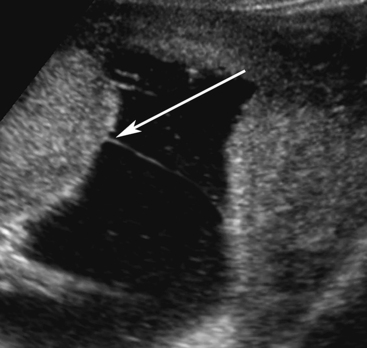
If the twins are dizygotic they should always have the lambda sign = dichorionic/ diamniotic
If the twins monozygotic and have the lambda sign = dichorionic/ diamniotic
If the twins are monozygotic and have the T-sign = monochorionic/ diamniotic
If the twins are monozygotic and have nothing separating them = monochorionic/ monoamniotic
These are important to understand and know how to identify them because we need to know if they share a blood supply/ placenta and have vascular connections
Allison, you're always spoiling us with these amazing post! You never fail helping me conceptualize and reflect with these complicated concepts. With the notes that you shared, I am going to draw each type of fetal twin type out to help me remember. In addition to its sonographic appearance.
Thanks SO much, queen!
Thanks Monica <3 ;)
Thank sounds like a really good idea. For me I just kind of think the longer the time passes the cells have already determined what they are going to be. So If the cells have already determined they are going to be something and split hasn't occurred yet the twins will share that set of cells. Also I like to remember that the chorion and the endometrium make up the placenta so if the twins share a chorion (monochorion) they would also share a placenta.
Here is a good image with all the different placentas

Allison, you did a beautiful job of breaking each of the twin types down into easy, understandable terms. It is definitely an overwhelming, new concept, and I'm sure we will all be pros at this by the end of the program, but for now it helps to see it explained like this. Bravo!
Hi Allison!
Your post is so thorough and informative. You alway have the best responses! I love how you took us back to the beginning of the quarter for a refresher by breaking down all of the steps an embryo transitions into.
This image I found online is super interesting and I can't even imagine scanning this many babies in one tummy! ;)
Can you tell what this multiple pregnancy would be called?
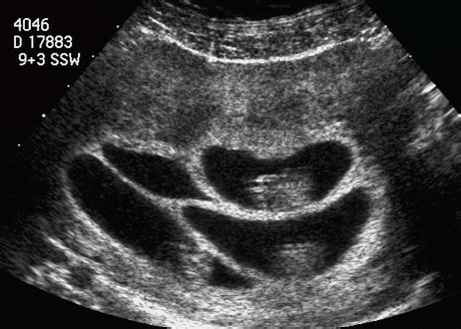
I love an image quiz haha!!
I would say this pregnancy would be a polychorionic/ polyamnionic or quadchorionic/ quadamnionic.
I see 4 lambda signs so it makes me believe they all have there own gestational sac or chorion. I don't see any amnions but if they all have their own chorion then be default they all should have their own amnions.
I feel like for sure with this many we would see a fused placenta!
Hi Allison,
Holy poop, EXCELLENT job on this post! Thank you for laying everything out like this, for sure it can be part of a study guide for OB finals.
Have you found any other issues that could arise from sharing chorions or amnions besides vascular connections?
Okay are you kidding me... This is so good.
This might be a stupid question but I think you might be able to help me better understand why different genders can't be from the same zygote.
Okay just kidding as I was typing it out I gave it more thinking and it is because one "girl" zygote can split into two girl zygotes but cannot split into one girl and boy zygote. I'm dumb and answered my own question... THANK YOU
Hey Candee,
Yea so when you have one sperm and one ovum that creates a zygote those cells have 46 chromosomes that is their DNA. So when that splits they share the same DNA (monozygotic). Dizygotic is when 2 ovum release and 2 separate sperm penetrate each ovum making two different zygotes. These 2 zygotes have a different set of 46 chromosomes/ DNA than each other. So although they are twins they are as alike as you and one of your siblings are.
I find metaphors helpful, and this article really helped me understand chorionicity and amnionicity:
https://jdc.jefferson.edu/cgi/viewcontent.cgi?article=1000&context=rsfp
It uses "The Apartment Analogy" similar to Dr. Wilson's example of houses on the same street.
For me, it helps to break things down into the simplest terms. The chorion, as we learned previously, is the outer membrane and is associated with placental formation. So chorionicity is going to determine the placental number, and therefore if the fetuses are sharing resources. If a gestation is dichorionic, it has to be diamniotic (otherwise you will have an empty gestational sac). So if you see the lambda sign, you know there are multiple membranes between the fetuses, illustrating both amniotic and chorionic layers.
If there is only one chorion, you can still have two amniotic sacs (monochorionic-diamniotic). These are still two separate living situations, but the wall between them is just amniotic membrane and therefore much thinner. This appears sonographically as the "T-sign".
The closest living situation monochorionic-monoamniotic, where they literally share a room.

Because twins have a higher risk of complications in monochorionic situations, it is important to accurately document amnionicity and chorionicity in multiple gestations.
Hi Leah,
Great post! I agree that Dr Wilson's analogy really fit and people could come back to it if they find themselves confused somewhere.
That's an excellent diagram you found! I love that it starts from zygosity, because when you throw that into the mix it can get a little confusing.
What do you think is the most life threatening complication that arises from sharing an amniotic sac?
In addition to the potential issues that can arise from sharing a chorion/placenta, I would suspect cord entanglement. However in reading this article from the National Library of Medicine, it sounds like their sample study of monoamniotic twins had more perinatal mortality from TRAPS, spontaneous miscarriage, and conjoined twins.
Chorionicity and amnionicity are two very important concepts when it comes to assessing multiple fetal gestations. Knowledge of these concepts allows a Sonographer to understand the type of multiple gestations, and with this information treat each one accordingly. Chorionicity refers to the number of chorions, in other words the number of fetal connections to mom. Amnionicity refers to the number amniotic cavities present. Each amnion has amniotic fluid that is essential to the fetus’s growth and development. I remember chorionicity as the one on the outside and the amnion as the one on the inside. The sonographic appearance varies on the type of multiple gestations. In the case of dichorionic, we should see two chorions and two amnions (diamniotic), which can represent fraternal twins of the same or opposite sex or identical twins. For monochorionic we should see one chorion and one (monoamniotic) or two amnions (diamniotic), which represents identical twins of the same sex. Chorionicity and amnionicity can increase as the number of fetuses increase. This information is important because monochorionic twins have vascular anastomoses of some sort, which means something can occur that affects the amount of nutrients each fetus receives. Conjoined twins may also occur when the zygots spilts after 13 days. Conjoined twins are monochorionic monoamniotic, and share vascular connectivity.
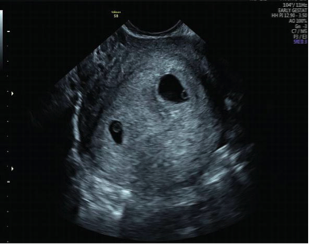
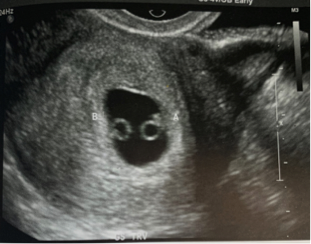
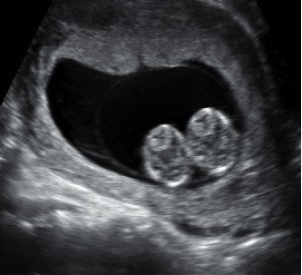
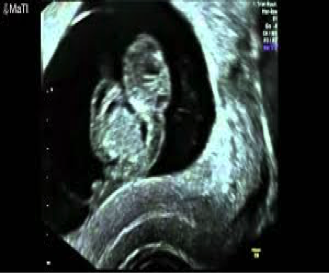
Hello Nailah!
I love the images that you shared! They're honestly quite tricky! This helps to get our eyes used to what there and whats really not there. Although it's great to also indicate what image contains what: Image 1 (dichorionc/ diamniotic) Image 2 (monochorionc/ monoamniotic) Image 3 (monochorionc/ monoamniotic) and Image 4 (dichorionic/ monoamniotic)...But I think I'm wrong... I could be debris? I like how Dr. Wilson referred to the chorion and amniotic as houses and rooms, or even sharing utilities. Its a helpful reminder. Just as your amazing presentation! Great job again!
Have a great weeks at clincals!!
Hello Monica,
I am glad you enjoyed my presentation, you are too kind! I should've been more clearer and labeled them all. It wouldn't transfer over well, so I had to add them all as files. Sorry. The first one id Di/Di, the second is Mono/Di, the third is Mono/Mono and the fourth is Mono/Mono also but with conjoined twins.
Have you been introduced to a twin protocol at your site?
I have the same hopes for you as well!
Hey Nailah!
Don't apologize! I don't ever get to see multiple gestational pregnancies what so ever at my clinical site. There is a separate department for high risk pregnancy and then there's the ultrasound department. From the looks of it, no one ever goes over to that side because there are specialist already there. Maybe at my next rotation? We will see! It's great that you shared these images because I need to get my eyes used to these ultrasounds. I was thinking there was a line in the last image. Thanks so much for clarifying those images!
Nailah great job on finding some great images to practice on!
I found these a little challenging, but here's my attempts at determining their chorionicity/amionicity:
1. DC/DA
2. MC, 2 yolk sacs, but amnions haven't yet developed, so we can't yet determine if it will be 2 or 1 amnions?
3. MC/MA
4. MC/MA, conjoined?
I'm not sure if my logic is correct so anyone pease correct me if I'm wrong! I liked this article, in the first part it talks about yolk sacs and amnionicity prediction early in pregnancy.
https://obgyn.onlinelibrary.wiley.com/doi/full/10.1002/uog.11160
Transvaginal ultrasound at 7 weeks' gestation demonstrated two yolk sacs in a monochorionic twin pregnancy:

Repeat transvaginal ultrasound at 9 + 2 weeks revealed a single amniotic sac and the absence of an intergestational membrane.

Hey Zuly,
You actually are spot on. The site I got the information from did describe number 2 as Mono/Di. I know some sources say its not good to use yolk sacs to determine amnionicity, but from doing my research for my presentation it seems like it varies. Are you seeing twins at your site? If so has your CI mentioned how she makes these determinations in early pregnancy? I only saw one so far at 9 weeks and it looked like it was mono/di.
Hi Nailah,
I think you did a great job laying information out in a way that is easily digestible.. and as you would, both you and Zuly were fantastic as presenters!! I do like that you mention as fetuses increase.. most people think of twins as just two when it comes to possible pregnancies. Imagine worrying about more than 2 at a time, as mom AND sonographer!!
Have you been seeing any OB scans at your site? Any twins?
Great post and presentation this week! I loved all the images you included at the beginning of your presentation. Even the adult twins were so cute!
The last image on your post is interesting! At first glance I had no idea what I was looking at, but I saw you said it is a case of conjoined twins. The close proximity of fetuses in the third image would have me worried about them being conjoined too. This would be an instance where we'd want to see them separate at some point during the exam to confirm they're not conjoined.
Amnioncitiy is the number of amnionic (inner) membranes that surround fetuses in a multiple pregnancy. Chorionicity is the number of chorionic (outer) membranes that surround the fetuses in a multiple pregnancy. chorionicity is best determined between 6-14 weeks gestation.
There are three types of twinning and these sonographic appearances help determine what twins you're dealing with:
Dichorionic-diamniotic- Twins who have their own chorions and amniotic sacs. They usually don't share a placenta and can be fraternal or identical depending on gender. With Dichorionic twins there should be a thick septum between the fetuses.
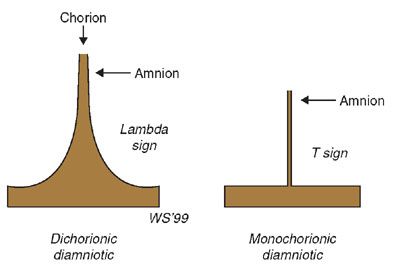
Hi Molly!
Great job breaking down all the different types twinning!
I was interested by the "extra point" question we had in class yesterday about triplets and it got me researching a bit. There are a few more ways the chorion and amnion can be with triplets vs twins, such as having trichorionicity or triamnionicity! It's so interesting that we could potentially have triplets but just two of them may be identical. Here's a little graphic I found that shows triplet pregnancies.
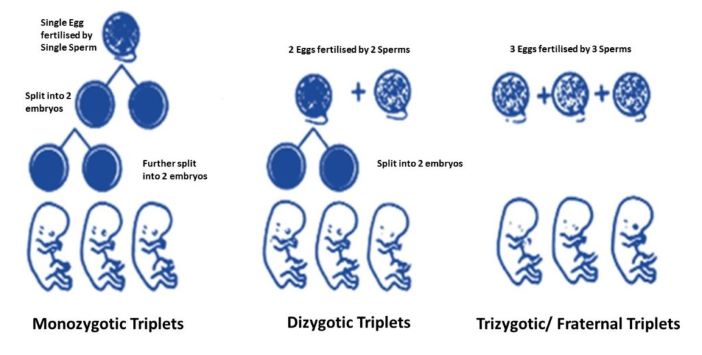
Hey Brit!
I love this research you did on triplets! That extra points quiz got us thinking that's for sure! Amazing how two could be identical and one fraternal. That is mind blowing! The visual definitely helps clearly understand the process.
Thank you for sharing!

So would this be a case of two twins being identical and the one being fraternal? Triplets are giving me a headache. LOL Definitely not confident with mult. gestations just yet.
Hi Molly and Britt!
I love this thread of images and discussion! I was wondering this when we had our lecture on Monday if this was possible. It is so amazing the things the body can do! The fact that there can possibly be a T sign and a lambda sign in a triplet pregnancy or pregnancy of more than three as well is something we definitely want to keep in the back of our minds to be on the lookout for as well.
Molly,
Check out this 3D of a di/tri. https://www.youtube.com/watch?v=JSmK5MYhBTE
A 31 week triplet US!!! https://www.youtube.com/watch?v=48uBJMztzKM I'm amazed at how well the tech found those hearts!
Also apparently there can be 4 identical siblings (assuming this is accurate) https://www.youtube.com/watch?v=DgxGa7-hVsY I tend to think it's real because I'm seeing a lot of other videos and articles on the topic. Wild.
Sarah
Hey Sarah!
Thanks for sharing those videos! The one of the twins gave me anxiety with how the tech was scanning with the left hand and the awkward positioning of the monitor making it hard to work the machine! And when she said baby C had a heart rate of 113 BPM I cringed! That's rather low. Great to see triplets being scanned that's for sure!
There's a family I follow on social media and they have 4 identical girls! So amazing!! I think it was made possible through IVF.
Here's a video I found of a twin pregnancy with one blighted ovum. Super interesting to see, so we can spot it when scanning.
Ultrasound Video showing twin pregnancy with one blighted ovum. - Bing video
Hi Molly great discussion board post I liked your visual of each of the membranes. However I was wondering why we see a septation between the membrane signs with the lambdasign if it represents diamniotic and dichorionic I am specifically thinking about the picture on the quiz.
Hey Molly,
This picture is amazing! I love how clear the description is. Have you seen any pregnancies? If so have you been able to see any of these signs?
*twin pregnancies
I also think a little trick I will use to remember the chorion is on the outside is that chorion covers. We put covers on everything now a days to protect the inside i.e cell phone covers, car seat covers. We can think of the chorion covering and protecting the amnion.
Hey Nailiah!
I've seen two sets of twins! Super exciting to watch them being scanned. When I saw those scans it was before truly learning about this weeks lecture in depth, but I remember the babies kept interlacing their legs and arms making it challenging for my CI to keep them separate. I believe the gestation would be considered monochorionic monoamniotic. The other one seen was a monochorionic diamniotic twin pregnancy with the T sign visualized.
I hope we get more twin studies soon so I can pay even better attention to the chorion and amnions.
Here's an image of T sign with Mo/Di twins:

Hello Molly!
Great response. I remember when Dr. Wilson was discussing "What would you initially comment during a multiple gestational pregnancy?" I was thinking, just as we comment what position the placenta is in, we would comment where the lambda sign lays too! Lol
Do you use anything silly to help you differentiate between the amnioncity and chorioncity? I like the "housing" concept to remind me.
Amnioncity is defined as the determination of the number of twins fetal amniotic membranes
Chorionicity is defined as the determination of the number of chorionic membranes adjacent to the uterus
via OB textbook by S. Stephenson and J. Dmitrieva

It's important to differentiate two and remember that as we are scanning a multiple gestational pregnancy we must investigate if each fetus has it's own chorion and amniotic sac! What helps me remember the difference is how Dr. Willson referred to the relationship as the fetuses are "sharing a home and in different rooms" = one chorion and two amnions.


Understanding the differences between amnionicity and chorionicity, then becomes a fun matching game with the different kind of twins that you may encounter! Its also important to note that chorioncity can predict the fetal adverse outcomes, just as monochorionc/ monoamniotic pregnancies have vascular anastomoses. The different sonographic appearances that can help indicate what type of twins we are dealing with is noticing that there is a lambda sign for dizygotic twins (dichorionic/ diamniotic) and monozygotic twins (dichorionic/ diamniotic). Although some differences seen would be the appearance of the T-sign for monozygotic twins (monochorionic/ diamniotic), however if there is nothing seen that is separating them it can be still be monozygotic twins (monochorionic/ monoamniotic). It is important to understand what kinds of twins that you are dealing with to keep a check up about how the fetus are developing or what to even expect for the fetal outcomes. As even monochorionic twins (image b) have about three times the mortality rate as dichorionic twins (image a).

Hi Monica,
Love what you posted from the OB book-- a different spin on the same thing is always another way to remember it! Also love the diagrams you included.. we're such an awesome group to be finding all these different visuals. I don't think I've seen a repeat yet.
Your last diagram is a beautiful representation of both sonographic signs.
It makes sense that when two growing beings are so close together (mono-di or mono-mono) there may be issues that come up.
Hey Monica!
The pictures you found are awesome! I looked more into the di/di separate placentas vs di/di fused placentas since that is one I struggle to remember sometimes. I found that, like mono/mono twins, di/di with fused placentas can have vascular anastomoses too!
Vascular anastomoses in dichorionic diamniotic-fused placentas - PubMed (nih.gov)
Amnionicity is the number of amnions that are seen around the fetuses of a multiple pregnancy, and chorionicity is the number of chorions seen in a multiple pregnancy. I remember the difference by remembering that the amnion will be the one enveloping the amniotic fluid, not the chorion, so the amnion is the inner membrane and chorion is the outer.
We will see the twin peak, or lambda, sign when we have dichorionic/diamniotic twins, which shows the thick membrane between the two fetuses with 4 layers, each having their own chorions and own amnions. These can come from either monozygotic or dizygotic multiples.
With monochorionic/diamniotic twins, we will see the "T" sign which is seen as a thin membrane of amnions meeting the chorion/placenta in a T shape (possibly perpendicular) instead of the triangle shape seen with di/di.
The last amnionicity/chorionicity we may see is mono/mono, where there will be no membrane between the to fetuses seen since they share the same amnion as well as chorion. This and the "T" sign are both important to note since they both mean the pregnancy is monozygotic, which has a higher risk of fetal abnormality. Monochorionic twins will also all have a vascular anastomoses, so it is important to know if they are monochorionic so that their growth can be closely compared to see if one baby is receiving more blood/flow/nutrition than the other.
The last way I can think of to determine the kind of twins is if you see twins that are opposite sex. Fraternal twins will always be dizygotic and therefore dichorionic/diamniotic since they obviously were created from two separate ovum/sperm fertilizations.
The picture I'm copying is NOT from a medical source but I have a question about it... I found it when trying to find some images of di/di twin gender and its actually captioned as a gag gift twin picture. So my question is, if this photo is labeled correctly with twin A being a boy and twin B being a girl, shouldn't we see a amniotic/chorionic membrane between the two fetuses since opposite sex twins must be di/di? Or is the membrane not visualized in every plane, or are the genders maybe inaccurate?

Hi Lauren!
I totally agree with you in regards to this image! When I first looked at it I thought that I wouldn't feel comfortable calling baby A a boy because the genitalia isn't totally clear and could actually be swollen labia instead of a penis. Then I thought well if it is a boy and girl where is the dividing membrane?!
If the fetal sex is correct, then there definitely needs to be a dividing amnion and chorion, making the pregnancy dichorionic diamniotic (and dizygotic), since identical twins cannot be different genders!
Great catch on this image. This reminds me of just how much we are learning to pick up on in these images and how we will definitely be able to tell a "gag gift" picture from a real ultrasound image!
Interesting, if true! I'd agree that in the case of male/female twins, we'd have to see a membrane separating them. The only other thing I can think of that may or may not be in the realm of possibility is a case of ambiguous genitalia in one of the twins (adrenal hyperplasia?).
After consulting with Dr. Google, apparently there have been cases of discordant phenotypic sex in monozygotic twins. These rare cases are often associated with Turner syndrome. Hopefully this will make more sense when we talk about Turner syndrome next quarter!
https://academic.oup.com/humrep/article/29/12/2814/630447
Ah yes!! Thank you for bringing ambiguous genitalia up! I considered this as well but I thought it may be caused by a genetic issue, which would then mean both twins have to have it if they're identical.
Turner syndrome is an interesting condition. I read that it is typically caused by a missing or partially missing X chromosome and I was curious how this could happen in one twin but not the other if they're genetically identical... The article you posted however explained that in that case both twins had 46 XX and 47 XXY cell lines, but they were present in different proportions in the twins, which explained their phenotypical sex differences.
Thanks for the article!
Hi Everyone!!
Lauren, great job on your post and way to post an interesting picture!! As Alexis and Brittany mentioned, I too think it may be a ambiguous genitalia issue going on... either that.. or is there a possibility that one fetus may be growing a bit slower than the other because of imbalance of nutrition/ blood supply?
They seem to close to have any kind of membrane between them.
Also great job ladies on reminding everyone that you CANNOT have identical twins that are two separate genders..
Except that sometimes it does happen, very rarely, with Turner's syndrome like you guys mentioned. Interesting topic! We need to question Candee more about what she saw at her site when she scanned the child with this syndrome.
https://www.twins.org.au/twins-and-families/frequently-asked-questions/62-twin-facts/19-can-male-female-twins-ever-be-identical
Lauren.
I believe these are both girls - it's hard to tell. I find it likely that this image has been edited though. It just looks off some how (other than a missing chorion). Monoamniotic twins (which these appear to be) can be conjoined. I doubt it's some illusive biological pathway because opposite gender conjoined twins don't exist.
On that note these girls may have a "thalamic bridge" according to this article. I guess that means whatever one twin feels the other will as well. I'd like to know what other things the girls have in common. Do they know what the other is thinking?
https://www.nytimes.com/2011/05/29/magazine/could-conjoined-twins-share-a-mind.html
I wonder if twin to twin transfusion syndrome can happen with conjoined twins. Probably not? I assume they share vasculature.
Sarah
Hello cuties,
As we know, chorionicity has to do with the chorionic membrane, which eventually develops into the placenta, and amnionicity has to do with the amniotic membrane, which contains amniotic fluid. The chorionic membrane is the thick membrane surrounding the gestational sac and the amnion is a thin membrane. So let's start off in the beginning of it all: fertilization. A fertilized ovum is a zygote and the day when the zygote divides is what determines the amnionicity and chorionicity of a multiple gestation pregnancy.
Fertilization starts 24 to 36 hours after ovulation and the sperm enters the ovum. The rapid division of cells, known as cleavage, occurs 24 to 30 hours after fertilization and continues to divide as the zygote travels through the fallopian tube. The cells keep on dividing and eventually become a ball of multiple tiny cells, called a morula and reach the uterus by day 4 where it starts becoming a blastocyst. The outer part of the blastocyst is called the trophoblast and will give rise to the placenta. The inner cell mass inside the blastocyst will give become the embryo. The blastocyst implants into the endometrium by day 7 and starts burying itself within the endometrium wall.

Now, if we are to follow this timeline, we can tell by when the zygote divides what type of pregnancy we will have:
Day 3= Dichorionic/Diamniotic
Days 4-7= Monochorionic/ Diamniotic
Days 8-13= Monochorionic/ Monoamniotic
Days 13+= Conjoined
![Twin Types. Monozygotic vs Dizygotic Twins -... - Stock Illustration [62376544] - PIXTA](https://en.pimg.jp/062/376/544/1/62376544.jpg)
When scanning multiple gestational pregnancies, we know to look out for the Twin Peak sign for a dichorionic pregnancy and the T sign for a diamniotic pregnancy. The twin peak sign is a triangular shape the chorions form when joining adjacent to each other and the T sign is the thin membranes of the amnions next to each other. The lack of thickness in the T sign confirms that the pregnancy is monochorionic.
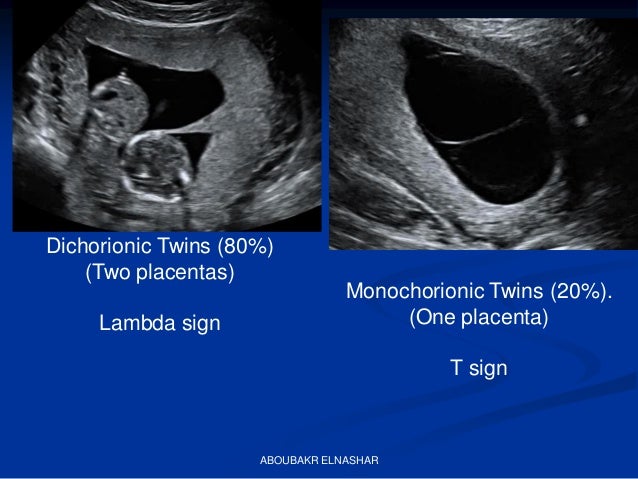
Knowing what to look out for sonographically is important because there are different risks associated with different conditions. For example, monochorionic pregnancies have the risk of developing Twin to Twin Transfusions Syndrome (TTTs) and this can lead to cardiac failure and even death of the fetuses.
Hey Top Ramen,
Great job on this post! Love that you did extra with incorporating the beginning of class into this week's db. And the way you incorporated the visuals to your post was very cohesive.
What other complications may arise with twinning? With sharing a chorion?
Have you been scanning early OBs on your own yet at clinics?
I like the discussion board this week because I feel like now that we are getting onto the third trimester I am forgetting the basis and what happens in the first trimester. I have been sort of confused on when the amnionic cavity disappears and why we don’t see in the second and third trimester as often. The chorion is the outer membrane and the amnion is the inner membrane that the fetus lives in.
Amnionicity is the thinner membrane you can have one or two amnions in twin pregnancies. One amnion then both fetuses would share one amniotic sac however if there was two amnions then each would have their own amniotic sac.
Chorionicity is the outer membrane and it's usually going to be thicker you can have one or two of these in twin pregnancies. They can have one chorion in which one or two amnions can live or there could be two chorion's with one amnion living in each.
To best determine what kind of twins whether it is a fraternal or identical twin or whether it is a mono mono, Di mono, or di di twin pregnancy. You might use gender to differentiate or you can use membranes. There can be two kinds of membranes the lambda sign or the T sign and the lambda sign is going to be a thick barrier between both sacs demonstrating that there are diamniotic in dichorionic or there could be a T sign demonstrating that there is monochorionic diamniotic and usually this will be a thin line separating the two. To be able to differentiate between what kind of twin pregnancy you're dealing with because of the pathology that might come with it.

Hi Candee! Awesome response. Remember too, even though it's rare (less than 1% of the time), that we may come across a twin pregnancy that won't show a lambda or T sign, which means its mono/mono and they share both (long and trans views of this below)! With these types of monozygotic twins, we need to carefully assess whether they are conjoined since a split after 13 days leads to a high risk of conjoined twins.
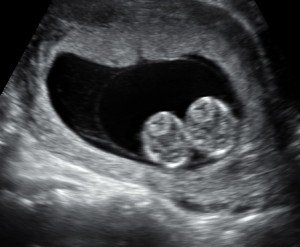
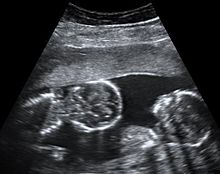
Hi Candee,
I couldn't agree with you more, this week's topic is a great refresher on embryology! It's only been a few weeks since we first discussed it, but I already feel rusty! This is another example of why having a solid understanding of embryology is so important. if we know the timeline at which certain events should occur its easier for us to understand where things went wrong when something doesn't form correctly, or in terms of twinning, which type we have depending on when the split occurred.
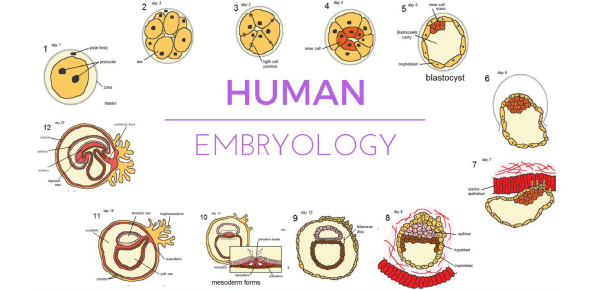
Hi Candee,
I think the hardest concept for me to understand for this class was the first trimester and I think it is probably one of the most important concepts because its the seed from which it all grows (see what I did there :P) The chorionic and amniotic membrane fuse together at about the 14th week of gestation, so a little into the second trimester as you mentioned. The amniotic membrane is inside of the chorionic membrane and the chorionic membrane develops chorionic villi in the endometrium, which supply nutrients to the developing fetus and this membrane eventually becomes the placenta. The amniotic membrane acts as a cushion and protects the developing fetus.
Hopefully this helps!
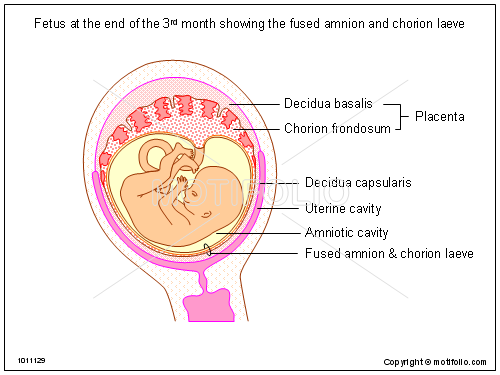

https://radiopaedia.org/articles/chorioamniotic-separation?lang=us
Great job, Candice!
I really like this week's discussion board as well because it's simple enough to understand yet complicated enough to be so interesting!
You going back to the beginning of class and running through everything from there is actually a great idea, I feel like everything kind of goes hand in hand and we've been so deep into each topic that we haven't really taken a step back and look at the overall picture.
Great job on your post, not everyone (including me) remembered to include using gender to differentiate types of twins.
Hi class,
I remember the baby is in the amniotic sac because baby floats in amniotic fluid. The chorion encapsulates the amnion. I remember this because it took me ages to understand embryology in the first few weeks, so I beat it into my head.
If I see a lambda sign I know I have 2 chorions and 2 amnions. If I see a T sign I know I have 1 chorion and 2 amnions. There can never be more chorions than amnions.
To tell if twins are mono/di or mono/mono look for the T sign. If that isn't seen try scanning through the amniotic cavity and look for a small echogenic line between the babies.
It's extremely important to know if the babies share a chorion or amnion for a ton of reasons. If they share a chorion there will always be some amount of anastomosis between the babies => this can cause one twin to be less developed than the other. If the twins share an amnion they run the risk of being conjoined.
Check out this article on conjoined twins. It's a bit long but just take a peek at the pictures if you can. https://www.sciencedirect.com/topics/medicine-and-dentistry/conjoined-twins
Sarah
Hi Sarah,
It’s really nice that the membrane name is in the name for amnionicity and chorionicity isn’t it? One less thing we have to worry about memorizing. Another way to prove di/di would be to check for gender and if we have a male and a female then we know its fraternal twins!
Great job Sarah I always love your responses
Hailey,
It's good to know that we have fraternal twins if the genders are different. As we know fraternal twins are the result of two eggs being released from the ovaries at once => then both eggs get fertilized. Identical twins must be the same gender because they come from the same egg (otherwise they wouldn't be identical!)
If the twins are identical they can have 1 or 2 chorions and 1 or 2 amnions. If the twins are fraternal they must be in 2 different chorions (because each egg will have its own chorion).
Sarah
Heya Sarah,
Great way to break down and simplify amnion and chorion relating to chorionicity and amnionicity! It really isn't too complicated if we draw it all out.
Also liked your common yet not so common sense of putting that there could never be more chorions than amnions... because if there were no amnions within the chorion it wouldn't exist. Based off of viable twin pregnancies of course.
Conjoined twinning always fascinates me! And it's kind of creepy to know that one twin was hogging more placental goodies than the other. Now it kind of makes me look at my twin friends differently. I wonder who was the hog, haha.
Excellent job!
Hi ladies!
Happy hump-day! We made it to mid-week. I don't know how but the weeks seem to drag yet fly by at the same time.
Gonna throw a little weird anomaly at ya... anyone heard of "fetus in fetu" before? What chorionicity/ amnionicity do you think these kinds of pregnancies would be for something like this to happen?
Hi Karen,
So I looked "fetus in fetu" and kind of wish I did not go to Google images! This condition is both frightening and interesting and is when a parasitic twin grows inside of its twin. Based off of this, I would say that it would have to be a monoamniotic and monochorionic pregnancy, because how would the parasitic twin get to its twin if there was a membrane separating them. However, the article I was reading said that most likely a diamniotic/monochorionic and monozygotic pregnancy in which parasitic twin becomes "incorporated into the body of the host twin after anastomosis of the vitelline circulation."
In the case I read about, a 15 year old went to the doctor for a hard abdominal mass. A CT scan revealed a huge intra-abdominal mass that contained deformed skull, long bones and vertebral body. Laparotomy was performed and the doctors took out a gestational sac. When they opened up the sac, a 1.6kg nonviable baby was taken out, with hair. deformed body, and normal baby skin. The pictures are pretty graphic but if you think you can handle it, I have the link to the article here:
https://casereports.bmj.com/content/2017/bcr-2017-220801
Thank you Karen for sharing such an interesting phenomenon! I have heard of people saying a twin ate the other as a joke but this is on some other level!
Hi Karen and Raman,
This phenomenon is truly terrifying and difficult to wrap my head around. As I was reading Ramans' response I initially thought of this being related to a "vanishing twin" but to be honest i am still unclear if that's connected or not. The article Raman shared had lots of great information and said this is thought to occur in a case of monozygotic twinning in which the twins are Monochorionic/Diamnionic. I found this to be a great read but also so scary to think there could be more people out there walking around with their twin sibling inside them...
Right, Chrishawna!! We hear about things like this but never really think about how or why it happens.. or at least I don't. It's a next level teratoma for sure!!
Great job on the research, Raman!
Here's a pic and article I found with fetus in fetu IN THE CRANIUM, found during a prenatal scan. Crazy stuff!
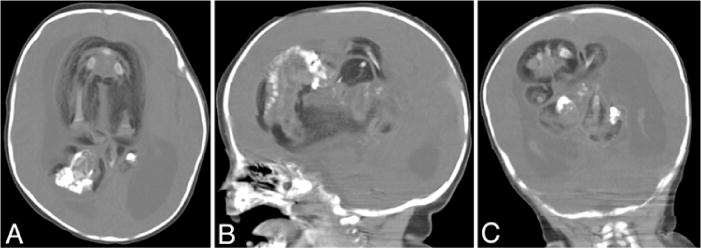
https://thejns.org/pediatrics/view/journals/j-neurosurg-pediatr/9/1/article-p17.xml
Oh my goodness! Thank you for bringing this pathology to the discussion board, it is super interesting to learn about. According to this report on two case studies, there have only been about 100 documented cases since it was originally "discovered".
"Fetus in fetu is a developmental abnormality in which a mass of tissue resembling a fetus forms inside the body." is what I found when I researched it and that is scary. The pictures are heart breaking. Im sure this would be a mono mono, with an incomplete separation of the zygotes.
Fetus in fetu is definitely one of the more terrifying pathologies, thankfully t's very rare! I didn't know beforehand that is controversial in that it's not understood it it's a nonviable fetus that becomes entrapped, or a highly organized teratoma.
This surgical removal of a "fetus in fetu" (at least thats what the title says), was interesting just as gross pathology, but I do think this looks more like a teratoma, so I can see why it's controversial. It's interesting to see even if it is just a teratoma.
Great job, Zuly!! I did see some articles talking about how they're not 100% on how this occurs.. but personally I would not consider "fetus in fetu" as a simple teratoma, only because they consider it a fetus, however parasitic and life dependent, that lives in a host body. Teratomas arise from germ cells and complications of the growth process, so I feel like there's a very, very thin line that separates them.
I may also be completely wrong, though, haha.
Love these responses!
It's finally weekend, ladies!!
This discussion board topic was sweet and to the point. You all went above and beyond with posting.
We went over:
- Zygosity--
- How many babies came from one ovum?
- Monozygosity ALWAYS leads to same sex twins, IDENTICAL.
- Multiple ovums fertilized will lead to FRATERNAL twins, may be same sex or xx and xy, having separate chorions
- How many babies came from one ovum?
- Chorionicity--
- Made of trophoblast cells
- How many chorions in the pregnancy?
- Chorions house the amniotic sac(s)
- Not possible to have more chorions than amniotic sacs
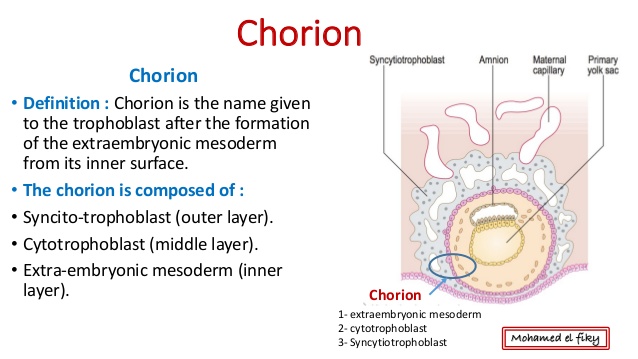
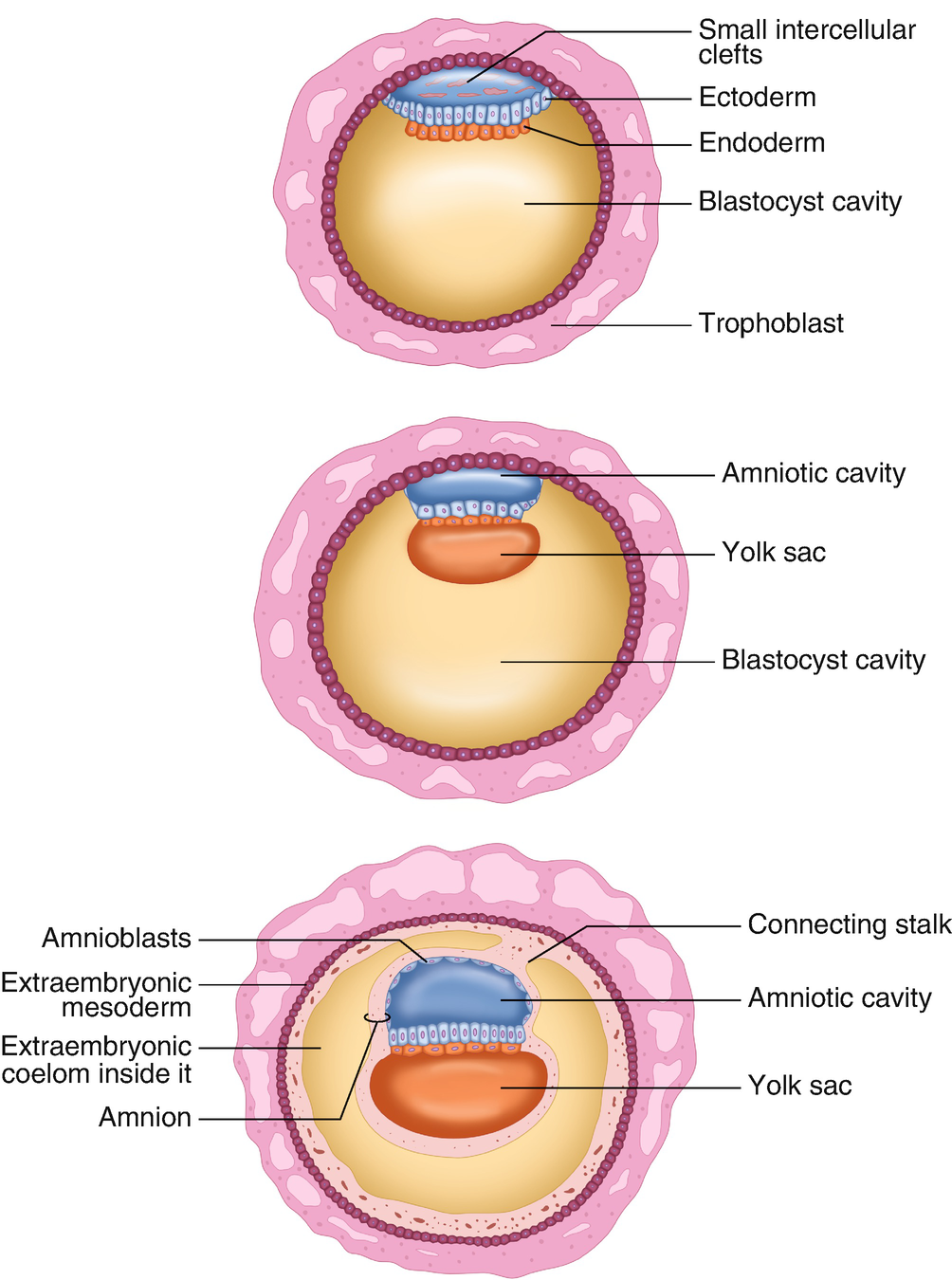
- Lambda or Twin Peak sign
- Amnionicity--
- Pouch of amniotic fluid that houses baby
- Inner membrane
- T sign
And as we know, timing has a lot to do with what type of twinning! For simplicity's sake we'll speak on 2 fetus twinning.
- If zygote splits < 3 days, it will be a dichorion, diamnion twinning.
- If zygote splits at ~4-8 days, it will be monochorion, diamnion twinning. These twins and any splitting after this point will have some sort of vascular placental anastamosis going on (TTTS, TRAP)
- If zygote splits at ~8-13 days, it will be monochorion, monoamnion twinning, really cramped quarters for babies.
- Any zygote that splits >13 days will result in monochorion, monoamnion CONJOINED twinning.
Suffice it to say that there will be a lot more important things to be looking out for when it comes to twins that share close spaces in mom! I'm glad we really hammered in some key points of what to look for between this and Leah's discussion board. I know just the amount of diagrams, explanations, and videos we've all pored over definitely made the information stick!
Thank you for a great discussion board. I hope more people will get to scan twins soon, including myself! Happy studying!
-Karen
